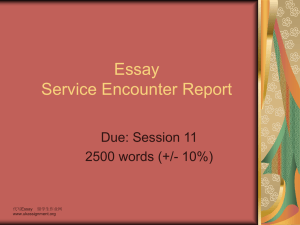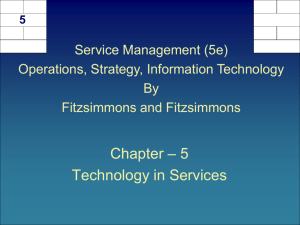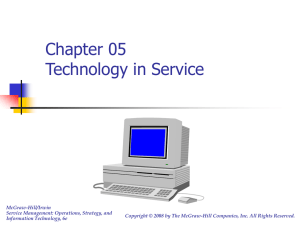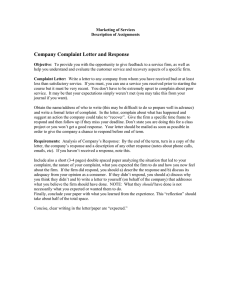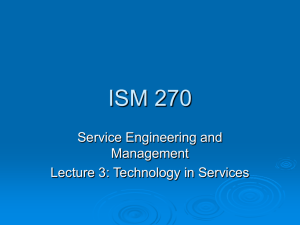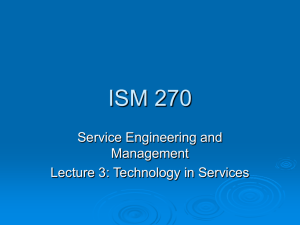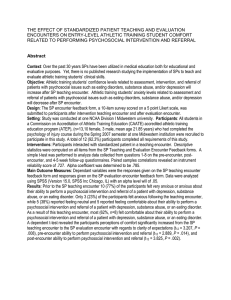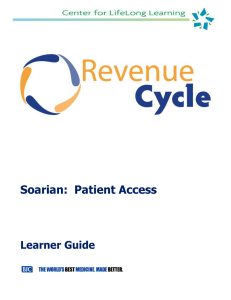Service Strategy, New Service Development, and Technology in
advertisement
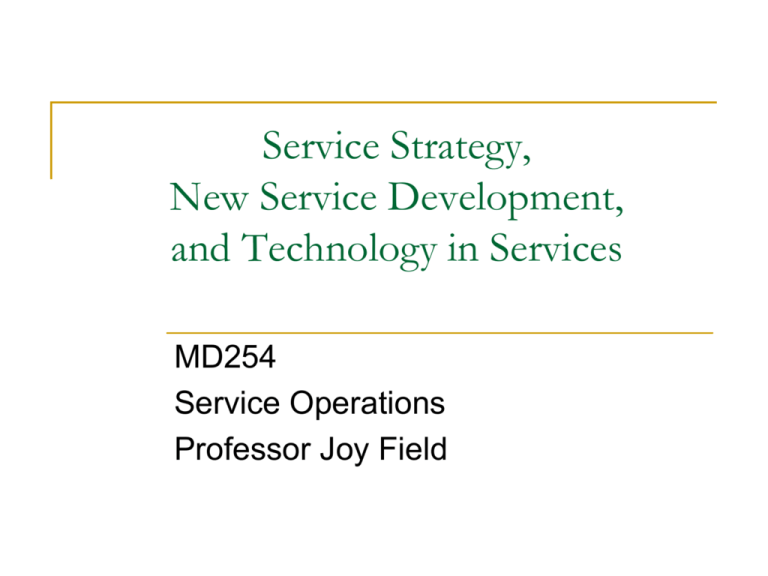
Service Strategy, New Service Development, and Technology in Services MD254 Service Operations Professor Joy Field Strategic Service Vision Target Market Segments What are common characteristics of important market segments? What dimensions can be used to segment the market (e.g. demographic, psychographic)? How important are various segments? What needs does each have? How well are these needs being served, in what manner, by whom? Strategic Service Vision Service Concept What are important elements of the service to be provided, stated in terms of results produced for customers (i.e., how is value created for the customer)? How are these elements supposed to be perceived by the target market segment, by the market in general, by employees, by others? How do customers perceive the service concept? What efforts does this suggest in terms of the manner in which the service is designed, delivered, marketed? Strategic Service Vision Operating Strategy What are important elements of the strategy: structural and managerial decisions and interfaces with other functional areas? On which will the most effort be concentrated? Where will investments be made? How will quality and cost be controlled: measures, incentives, rewards? What results will be expected versus competition in terms of, quality of service, cost profile, productivity, etc.? Strategic Service Vision Service Delivery System How is the service delivery system implemented, including: role of people, technology, equipment, layout, procedures? What capacity does it provide, normally, at peak levels? To what extent does the service delivery system help insure quality standards, differentiate the service from competition, provide barriers to entry by competitors? Competitive Environment of Services How do each of these factors affect the competitiveness of service firms? Entry Barriers Economies of Scale Sales Fluctuations Power Dealing with Buyers or Suppliers Product Substitutions for Service Customer Loyalty Exit Barriers Examples of Competitive Priorities Availability Convenience Dependability Customization Price Quality Reputation Safety Speed (24 hour ATM) (Site location) (On-time performance) (Personalization) (Quality surrogate) (Perceptions important) (Word-of-mouth) (Customer well-being) (Avoid excessive waiting) Winning Customers in the Marketplace Service Qualifier Service Winner To be taken seriously a certain level must be attained on the competitive dimension, as defined by other market players. Examples are cleanliness for a fast food restaurant or safe aircraft for an airline. The competitive dimension used to make the final choice among competitors. Example is price. Service Loser Failure to deliver at or above the expected level for a competitive dimension. Examples are failure to repair auto (dependability), rude treatment (personalization), or late delivery of package (speed). Competitive Role of Information in Services Creation of barriers to entry Reservation systems Frequent use club Switching costs Revenue generation Yield management Point of sale Expert systems Database asset Selling information Developing services Micromarketing Productivity enhancement Inventory status Determining relative efficiency and productivity improvement levers Limits in the Use of Information Anti-competitive (e.g. barrier to entry) Fairness (e.g. yield management) Invasion of Privacy (e.g. micro-marketing) Data Security (e.g. medical records) Reliability (e.g. credit report) Service Design Elements Structural Delivery system: Process structure, service blueprint, strategic positioning Facility design: Servicescapes, architecture, process flows, layout Location: Geographic demand, site selection, location strategy Capacity planning: Strategic role, queuing models, planning criteria Managerial Information: Technology, scalability, use of Internet Quality: Measurement, design quality, recovery, tools, Six Sigma Service encounter: Encounter triad, culture, supply relationships, outsourcing Managing capacity and demand: Strategies, yield management, queue management Customer Value Equation Results produced for the customer Process quality Value Price to the customer Costs of acquiring the service Results produced for the customer Process quality Price to the customer Cost of acquiring the service Hotel Service Blueprint Strategic Positioning through Process Structure Degree of Complexity Measured by the number of steps in the service blueprint. For example, a medical clinic is less complex than a general hospital. Degree of Divergence Amount of discretion permitted the server to customize the service. For example, a high-end vs. low-end hotel has more personalized services. Generic Approaches to Service Design Production Line Limit Discretion of Personnel Division of Labor Substitute Technology for People Standardize the Service (low divergence) Customer as Co-Producer Self-Service (matching capacity with demand) Smoothing Service Demand (appointments, reservations, waiting) Customer-Generated Content Customer Contact Degree of Customer Contact Separation of High and Low Contact Operations Sales Opportunity and Service Delivery Options (channels) Information Empowerment Employee empowerment Customer empowerment Role of Technology in the Service Encounter Technology Customer Technology Server A. Technology-Free Service Encounter Customer Technology Server B. Technology-Assisted Service Encounter Technology Customer Customer C. Technology-Facilitated Service Encounter Technology Server D. Technology-Mediated Service Encounter Customer Server Server E. Technology-Generated Service Encounter Technology Convergence Enabling E-Business Internet Global telephone system Communications standard TCP/IP Addressing system of URLs Personal computers and cable TV Customer databases Sound and graphics User-friendly free browser Uses for Websites Retail channel (amazon.com) Supplemental channel (Barnes & Noble) Technical support (Dell Computer) Embellish existing service (HBS Press) Process orders (Delta Airline) Convey information (Kelly Blue Book) Communicate with membership (POMS.org) Play games (addictinggames.com) E-Business Models Content Provider: Reuters Direct-to-Customer: Dell Full-Service Provider: GE Supply Co. Intermediary: eBay Shared Infrastructure: SABRE Value Net Integrator: 7-Eleven Japan Virtual Community: Monster.com Whole-of-Enterprise: Government Economics of E-Business Sources of Revenue Transaction fees Information and advice Fees for services and commissions Advertising and listing fees Ownership of customer data Sources of Cost Reduction Efficiencies (self-service) Scalability Network effects Challenges of Adopting New Technologies in Services Loss of personal attention Customer acceptance Customer skills Tradeoffs (e.g. convenience vs. cost or time) Standardization (e.g. RFID) Lack of patent protection impedes innovation



